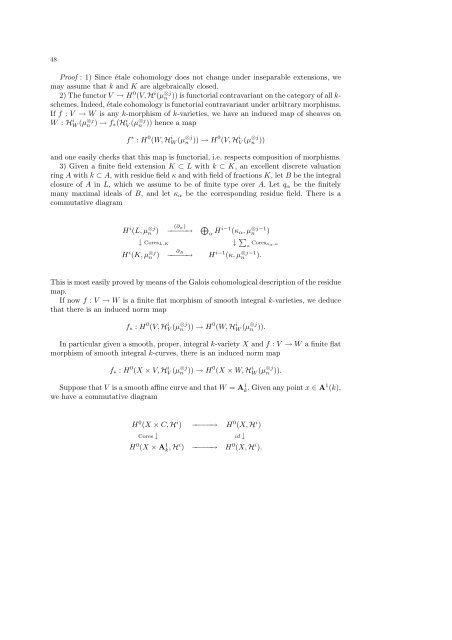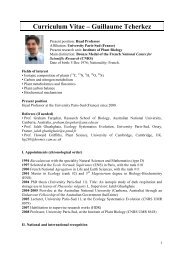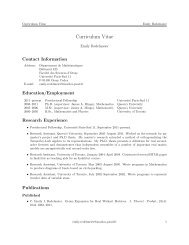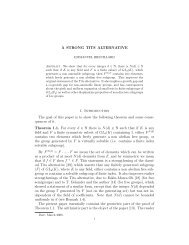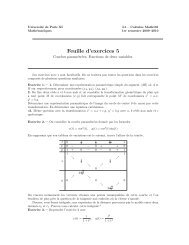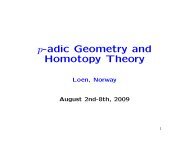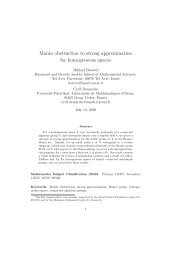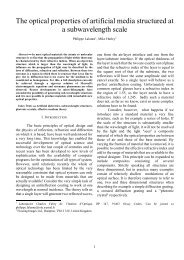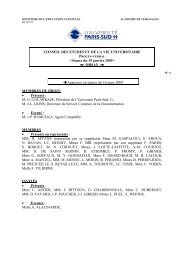Birational invariants, purity and the Gersten conjecture Lectures at ...
Birational invariants, purity and the Gersten conjecture Lectures at ...
Birational invariants, purity and the Gersten conjecture Lectures at ...
Create successful ePaper yourself
Turn your PDF publications into a flip-book with our unique Google optimized e-Paper software.
48<br />
Proof : 1) Since étale cohomology does not change under inseparable extensions, we<br />
may assume th<strong>at</strong> k <strong>and</strong> K are algebraically closed.<br />
2) The functor V → H 0 (V, H i (µ ⊗j<br />
n )) is functorial contravariant on <strong>the</strong> c<strong>at</strong>egory of all k-<br />
schemes. Indeed, étale cohomology is functorial contravariant under arbitrary morphisms.<br />
If f : V → W is any k-morphism of k-varieties, we have an induced map of sheaves on<br />
W : HW i (µ⊗j n ) → f ∗ (HV i (µ⊗j n )) hence a map<br />
f ∗ : H 0 (W, HW i (µ ⊗j<br />
n )) → H 0 (V, HV i (µ ⊗j<br />
n ))<br />
<strong>and</strong> one easily checks th<strong>at</strong> this map is functorial, i.e. respects composition of morphisms.<br />
3) Given a finite field extension K ⊂ L with k ⊂ K, an excellent discrete valu<strong>at</strong>ion<br />
ring A with k ⊂ A, with residue field κ <strong>and</strong> with field of fractions K, let B be <strong>the</strong> integral<br />
closure of A in L, which we assume to be of finite type over A. Let q α be <strong>the</strong> finitely<br />
many maximal ideals of B, <strong>and</strong> let κ α be <strong>the</strong> corresponding residue field. There is a<br />
commut<strong>at</strong>ive diagram<br />
H i (L, µ ⊗j<br />
n )<br />
(∂ α )<br />
−−−−−→<br />
⊕ α Hi−1 (κ α , µ ⊗j−1<br />
n )<br />
↓ Cores L,K<br />
H i (K, µ ⊗j<br />
n )<br />
∂ A<br />
−−−−−→<br />
↓ ∑ α Cores κα,κ<br />
H i−1 (κ, µ ⊗j−1<br />
n ).<br />
This is most easily proved by means of <strong>the</strong> Galois cohomological description of <strong>the</strong> residue<br />
map.<br />
If now f : V → W is a finite fl<strong>at</strong> morphism of smooth integral k-varieties, we deduce<br />
th<strong>at</strong> <strong>the</strong>re is an induced norm map<br />
f ∗ : H 0 (V, HV i (µ ⊗j<br />
n )) → H 0 (W, HW i (µ ⊗j<br />
n )).<br />
In particular given a smooth, proper, integral k-variety X <strong>and</strong> f : V → W a finite fl<strong>at</strong><br />
morphism of smooth integral k-curves, <strong>the</strong>re is an induced norm map<br />
f ∗ : H 0 (X × V, HV i (µ ⊗j<br />
n )) → H 0 (X × W, HW i (µ ⊗j<br />
n )).<br />
Suppose th<strong>at</strong> V is a smooth affine curve <strong>and</strong> th<strong>at</strong> W = A 1 k . Given any point x ∈ A1 (k),<br />
we have a commut<strong>at</strong>ive diagram<br />
H 0 (X × C, H i ) −−−−−→ H 0 (X, H i )<br />
Cores ↓<br />
id ↓<br />
H 0 (X × A 1 k , Hi ) −−−−−→ H 0 (X, H i ).


